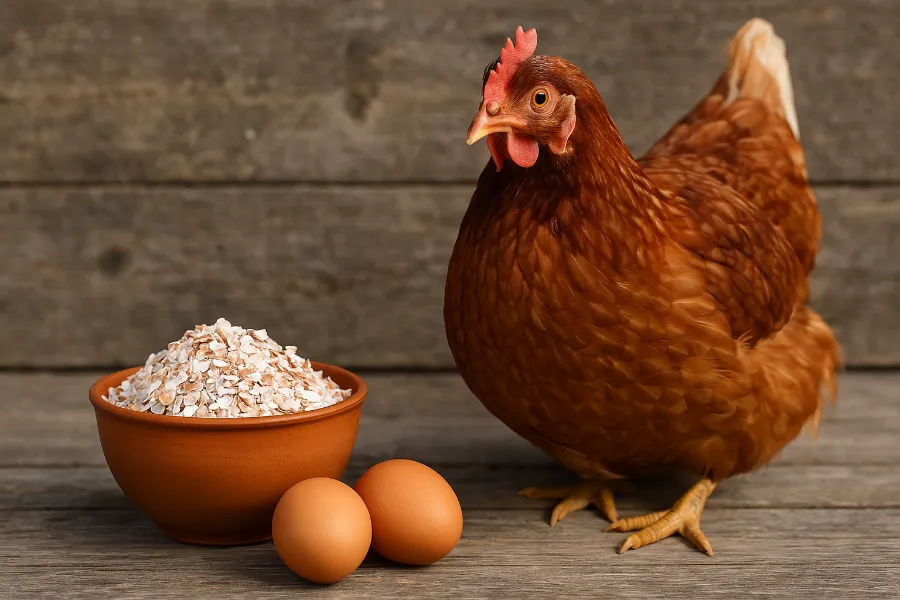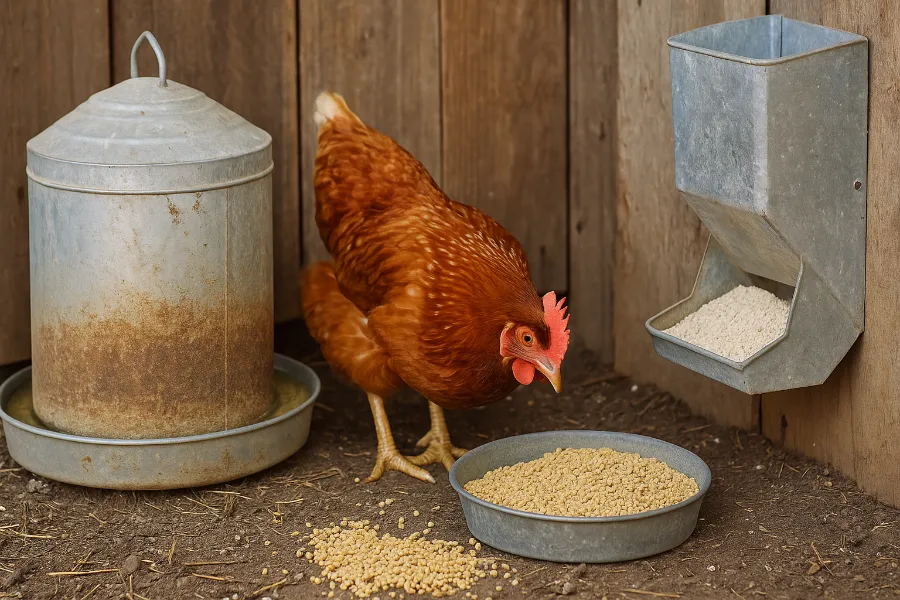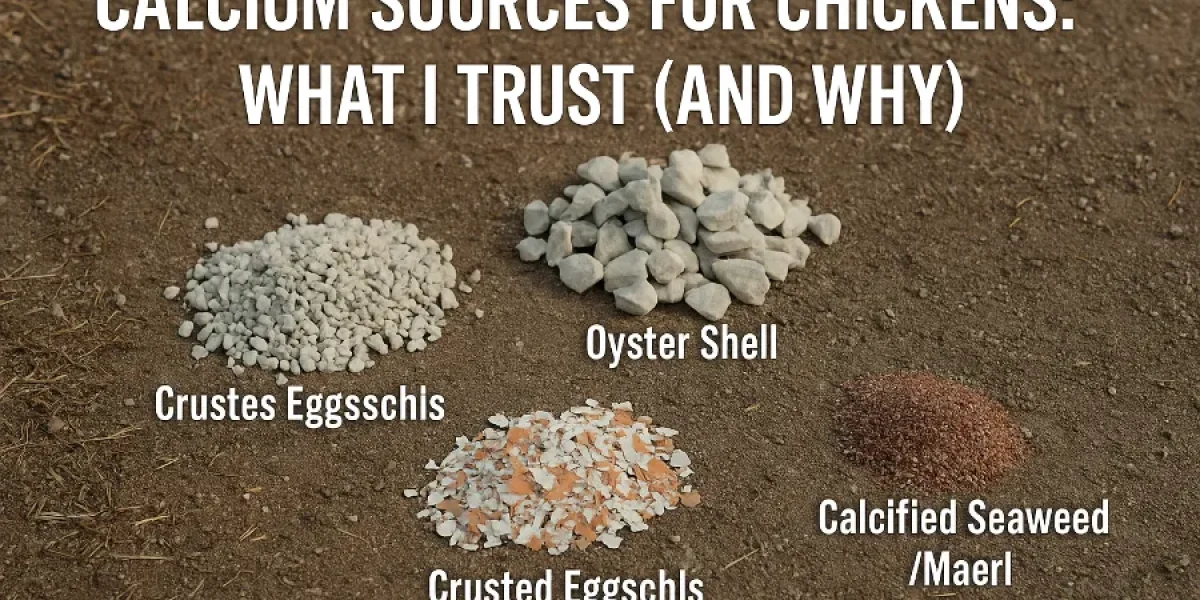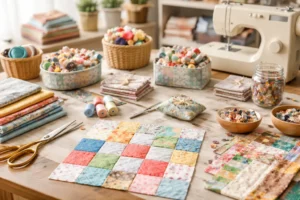When I first brought home my flock, I was obsessed with the perfect egg — smooth shell, no cracks. I quickly learned that calcium for hens isn’t just a “nice to have” — it’s the foundation of shell strength. Without enough, your girls will lay weak, crumbly shells (or worse, soft or shell-less eggs). Over the years, I’ve tried nearly every trick in the book, faced failures, and refined a system that really works. In this post, I’ll walk you through everything I know — in a friendly, no-fluff way — about how to feed calcium effectively, naturally, and sustainably.
I also want to help you outrank other guides, so I’ll dig into calcium sources for chickens, calcium carbonate for chickens, the best poultry feeding guide strategies, and yes — even alfalfa for chickens. Let’s get to it.

Calcium Sources for Chickens: What I Trust (and Why)
When I started, I tried feeding crushed eggshells, oyster shell, limestone — I even tested seaweed blends. After some trial and error, here are my favorites for a real flock, not just theory.
Oyster Shell (Coarse)
This is my “go-to” source. It’s mostly calcium carbonate, but in a coarse texture that gives your hens a slow-release calcium store through the night (when shells form). I keep it free-choice — that means a separate hopper they can peck at anytime. Over the years, I’ve found almost every hen uses it smartly — she eats just what she needs.
Limestone (Crushed Calcium Carbonate)
Limestone (crushed rock) is cheaper and works well, especially for short-term corrections. The caveat: particle size matters. If it’s too fine, it passes too fast (so it doesn’t help much overnight). If it’s coarse, it can mimic oyster shell’s effect. I usually mix in 1–2% limestone into feed for a week or two if my shells dip, then go back to regular.
Crushed Eggshells
This feels satisfying — it’s free, recycled, and neat. But it’s tricky. If hens recognize it as shell, they might peck eggs. To use it safely:
- Rinse, bake at ~200-250 °F for 10–15 minutes to sterilize.
- Crush to pea-gravel size (not powder).
- Mix into or offer beside other calcium sources — not as the sole source.
In my system, eggshells augment, not replace, oyster shell or limestone.

Calcified Seaweed / Maerl
I experimented with this when I wanted trace minerals in addition to calcium. It’s pricey, but some flocks respond with stronger shells. I reserve seaweed blends for premium flocks or breeding stock.
High-Calcium Grubs (e.g. Black Soldier Fly Larvae)
If you keep insects, high-calcium grubs can be a bonus source. But they’re a “treat” — not your core strategy. Use them at ≤10% of total intake. They’re a nice backup, not a replacement.
Commercial Layer Feeds (with Built-In Ca)
A good layer feed will already contain calcium, usually via calcium carbonate for chickens (or shell-derived sources). That’s your foundation — then you layer extras on top.
Calcium Carbonate for Chickens: Why It’s Everywhere (and How to Use It)
When reading any ingredient label on layer feed or supplements, you’ll almost always find calcium carbonate. It’s the go-to because:
- It’s readily absorbed in the digestive tract.
- It’s chemically the same form hens use for bone and shell.
- It’s widely available and cost-effective.
But here’s the catch: how fine or coarse your calcium carbonate is makes a big difference.
- Fine-ground calcium carbonate dissolves quickly. Good for fast correction, but it doesn’t hold through the night.
- Coarse-ground calcium carbonate (pea-size or larger) lingers longer in the gizzard and helps feed the shell-building process overnight.
In practice, I use a mix: a base feed with fine calcium carbonate + a hopper of coarse oyster shell or coarse calcium carbonate. This gives my hens a balance of immediate and slow-release calcium.

Poultry Feeding Guide: My System That Works Year-Round
Here’s my poultry feeding guide distilled from years of hands-on experience and research. Use this as your template, then adapt to your flock size, climate, and resources.
Basic Rules (for Layers)
- Aim for 4–4.5 g elemental calcium per hen per day.
- Use a layer feed with 3.5–4.2% calcium (or supplement on top).
- Always pair with vitamin D3 — hens can’t absorb calcium without it.
- Provide free-choice coarse calcium (oyster shell or coarse carbonate).
- Use fans, shade, and hydration in heat — heat stress reduces feed & calcium intake.
Daily Ration Example for 10 Hens
- Layer feed: ~1.3–1.6 lb (depending on your strain and season).
- Calcium hopper: keep ~1–2 lb of coarse shell or carbonate.
- Occasional correction: 1–2% limestone for 7 days if shells dip.
- Grit and clean water always available.
Seasonal Adjustments
- Summer / heat: Split feeding (morning + evening), move some calcium access late afternoon.
- Winter: Birds eat more, so calcium intake often rises naturally.
- Molt: Their laying slows; reduce extra calcium, but keep basics available.
Monitoring & Feedback
Every week, collect a few eggs and test shell quality (weight, thickness, break strength). When 2+ eggs are thin or cracked in a week, trigger a “boost” period: add 1% limestone for 7–10 days, then revert and watch results.
Alfalfa for Chickens: My Secret Helper
One thing I added later — alfalfa for chickens — that gives me extra strength in shell quality without adding bulk costs.
Why Alfalfa?
- It offers 1.2–1.5% calcium (dry matter basis).
- Rich in protein, vitamins, and minerals.
- Enhances calcium absorption, supporting bone and shell health.

How to Use It
- Alfalfa meal (5–8% in winter mash).
- Alfalfa “snacks” (dried or fresh leaves).
- Pellet form in coops or forage areas.
I never count alfalfa alone as my calcium source — but I treat it as an absorption booster and nutritional enhancer.
Troubleshooting: When Shells Fail — What I Do Next
Even with the best plan, things occasionally wobble. Here’s my checklist of what to try next:
- Check feed — has the batch changed? Is calcium and D3 properly included?
- Add coarse calcium access inside coop late afternoon (hens sometimes skip outdoor hopper at night).
- Run a short corrective mix — 1–2% coarse limestone in the feed for a week, then stop and evaluate.
- Inspect vitamin D supply — hens need sunshine or D3 in feed. Lack of D3 is a silent limiter.
- Watch strain & age — older hens often need more calcium reserve, and some breeds are naturally thinner shells.
- Avoid high-phosphorus treats (meats, legumes) — these can block calcium absorption.
- Check stress and health — parasites, heat, illness all reduce appetite and uptake.
If shells don’t improve in 10–14 days, there’s often a deeper issue (vitamin D, genetics, disease) rather than just “not enough calcium.”
My Day in the Life (With Calcium Focus)
To make this feel less abstract, here’s how I run my calcium program day-to-day:
- Morning: Top off layer feed. Refill water. Check calcium hopper.
- Afternoon (especially in heat): I toss a little extra shell in coop or open a side door so hens can snack inside.
- Late afternoon: If I spot any bird that has dropped a weak shell, I hand-feed ~½ teaspoon coarse shell.
- Evening: Check that shell hopper still has supply (I never let it run low).
- Weekly: Weigh average shell, look for cracks. If two eggs this week are weak, run the corrective limestone for 7 days.
I call this “feed, observe, adjust”—not complicated, but effective.
Final Thoughts & Encouragement
Switching to a calcium program focused on calcium for hens changed my flock. Shells got thicker, breakage dropped, and my hens laid stronger eggs even under heat or stress. Yes, it takes diligence — topping feeders, baking eggshells, scanning the coop at dusk — but the payoff is worth it.
If I were you, I’d start with:
- A solid layer feed with D3.
- A free-choice coarse calcium (oyster shell, coarse carbonate).
- Occasional limestone boost if things dip.
- A sprinkle of alfalfa to polish up absorption.
Over time, you’ll see those shells get rock-solid. And you’ll know: you built that strength from the inside out.
FAQs
Laying hens need about 4–4.5 grams of calcium per day to form strong eggshells. A good layer feed combined with free-choice oyster shell usually meets this requirement.
Coarse oyster shell is the most reliable natural calcium source. It provides a slow, steady release overnight when hens form eggshells.
Yes, but bake them first to kill bacteria and crush them well so they’re unrecognizable. Use them as a supplement, not the sole calcium source.
Calcium carbonate helps hens build strong shells and maintain bone health. It’s found in oyster shell, limestone, and most layer feeds.
Thin shells often mean calcium or vitamin D3 deficiency. Try adding coarse oyster shell and ensure they’re getting enough sunlight or D3-enriched feed.
Yes. Alfalfa for chickens provides moderate calcium plus vitamins that improve absorption. It’s best used alongside other calcium sources.
Keep coarse calcium (like oyster shell) available free-choice all day. Hens usually eat more in the late afternoon, just before nighttime shell formation.













